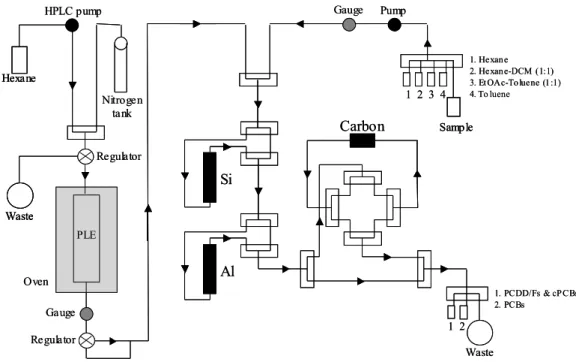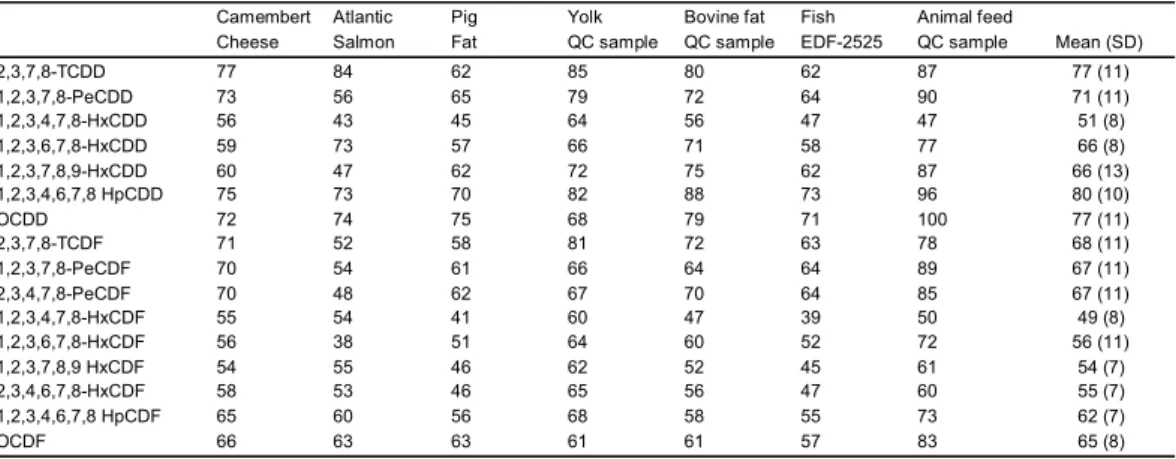ORGANOHALOGEN COMPOUNDS
Vol. 55 (2002)
33
ANALYSIS I
ON-LINE AUTOMATED PLE AND MULTI-COLUMN CLEAN-UP
SYSTEM FOR PCDD/F AND PCB ANALYSIS IN FOOD SAMPLES
Jean-François Focant1, Hamid Shirkhan2 and Edwin De Pauw1
1Mass Spectrometry Laboratory, University of Liège, B6c Sart-Tilman, B-4000 Liège, Belgium. e-mail
: JF.Focant@ulg.ac.be
2Fluid Management Systems, Inc., 56-58 Felton Street, Waltham, MA 02453, USA.
Introduction
Currently, a large variety of studies are conducted in order to monitor dioxins and PCB levels present in our food web. New regulations are continuously entering the scene [1], forcing scientists to develop more reliable methods. As driving criteria, quality of the analysis and high sample throughput are located at the top of the list. Knowing that most of (accredited) laboratories performing in the field exhibit good quality insurance data along with their results, one can assume that this part of the goal is achieved. Concerning the sample throughput side, however, only few laboratories can fulfil requirements. This being mainly due to the complexity of combining extraction, clean-up and analysis in an integrated fashion.
For several years, new extraction techniques have emerged [2] and present such advantages as lower solvent consumption, suitability for automation and higher turnover. The clean-up step has also evolved from childhood semi-automated stage [3] to entirely automated systems suitable to prepare large number of samples [4,5,6]. Nevertheless, extraction and clean-up steps still suffer from a lack of integration.
Following that trend, we reported last year a new automated extraction and clean-up apparatus suitable to accommodate biological fluids such as milk and serum [7]. This system was based on an on-line C18 extraction step incorporated in a multi-column clean-up assembly, reducing the sample preparation time to less than 2 hours. Since many of the food-stuffs and animal feeding-stuffs samples one has to process are in solid or semi-solid state, an alternative to C18 was requested to enlarge the use of the automated system to such samples.
Pressurised liquid extraction (PLE), which rests on the use of artificial pressure in order to perform the extraction at temperature greater than the normal boiling point of the extracting solvent, is a technique that allows to decrease solvent viscosity and to increase diffusion coefficients [8]. As a result, it has been observed that quantitative recovery can be achieved in reduced amount of time (e.g. few minutes) regarding to hours for more classical methods such as Soxhlet [9]. In addition, it is well suited to accommodate solid samples and to be further automated. For these reasons, we investigated the feasibility of the on-line coupling of such an extraction technique with the existing automated Power-PrepTM
clean-up system (Fluid Management Systems, Waltham, MA, USA). In this paper, we present an integrated automated continuous PLE and multi-column system capable to simultaneously extract and purify up to 5 solid samples in less than 2 hours for high throughput analysis of PCDD/Fs and PCBs.
Materials and methods
Samples
Various food-stuffs samples were investigated. Camembert cheese and Atlantic salmon samples were purchased in local high delivery rate supermarket in the area of Liege (Belgium) during April
ORGANOHALOGEN COMPOUNDS
Vol. 55 (2002)
34
ANALYSIS I
2002. Pork meat issued from a national monitoring campaign. After homogenisation, samples were lyophilised in order to remove water. Dried matrices were then manually grinded to produce a fine powder ready to be extracted by PLE. Producers’ lipid content values were used to evaluate the amount of sample required to yield to a portion between around 4 g of fat. In house bovine fat, eggs yolk and animal feeding-stuffs QC samples were also analysed. A contaminated natural fish certified reference material (EDF-2525, Cambridge Isotope Laboratories, Andover, MS, USA) was analysed to test the new system against reference data.
Automated extraction and clean-up
Automated extraction and clean-up were performed on an home-built prototype system based on Power-PrepTM
system [6], as illustrated in Fig.1. Stainless steel extraction cells were filled out with various amounts of samples depending their fat content. The entire sequence of events constituting the extraction and clean-up process was PC controlled and lasted less than 2 hours.
Analysis
GC/HRMS analysis (isotopic dilution method) were performed using Autospec Ultima high-resolution mass spectrometer (Micromass, Manchester, UK) operating at a high-resolution of 10.000 in the selected ion monitoring mode (SIM) and an Agilent (Palo Alto, CA, USA) 6890 Series gas chromatograph equipped with a Rtx-5MS (40 m x 0.18 mm x 0.18 µm) capillary column (Restek, Interscience, Louvain-la-neuve, Belgium).
Results and Discussion
The plumbing diagram of the new system is illustrated in Fig.1.
Figure 1. Modified plumbing diagram for integrated PLE and clean-up on the Power-PrepTM
ORGANOHALOGEN COMPOUNDS
Vol. 55 (2002)
35
ANALYSIS I
The plumbing of the system has been designed to allow control of the flow rate at the down stream side of the extraction column, resulting in the production of a constant solvent flow independently to applied pressure and temperature. This parameter was important 1) to ensure an efficient mass transfer rate, 2) to ensure a permanent supply of fresh solvent to the cell, 3) to ensure constant feeding of the silica column and 4) to avoid any clogging due to extensive static residence time of the solvent inside the cell. The extractions were typically performed using hexane as solvent. Temperatures ranged between 120 and 150°C and the pressure was between 2000 and 4000 p.s.i., depending on the matrix. Nitrogen gas (20 p.s.i., 1 min.) was applied at the end of the extraction to achieve release of solvent remaining in the cell through the multi-layer silica column. A classical clean-up program was then performed to complete the sample preparation and perform the fractionation process yielding to the isolation of purified extracts either in hexane:dichloromethane (PCBs) or in toluene (PCDD/Fs and cPCBs) [6,10].The investigated matrices were selected in order to be representative of samples one usually has to process in a food-stuffs monitoring laboratory. Lipid content ranged between 10 and 90% (fresh weight basis). For the present study, the amount of dried sample processed through the on-line extraction and clean-up ranged between 5 and 35 g (0.5 to 8 g of fat).
Table 1. Typical recoveries (labeled compounds) for investigated matrices.
These recovery rates (Table 1) are in average a little lower than the one we can observe using an off-line PLE system. This is mainly due to the fact that the internal standard is normally added to the fat after the extraction step when performing off-line. In the present study, the labeled compounds were added to the sample prior extraction.
For both salmon and pig fat, native compounds were recorded. For pig, measured values (1.47 pg TEQ/g fat for PCDD/Fs and 2.08 pg TEQ/g fat for cPCBs) were less than 5% away from values produced by accredited method. Quality control samples were used to have a measure of the extraction efficiency regarding native compounds. As illustrated in Fig.2, measured values were included in a 95% confidence interval (dotted lines) for all investigated QC samples. It is interesting to note that even in the case of animal feeding-stuffs, hexane shown to be quite efficient although toluene is generally preferred for such matrix. The continuous aspect of the extraction and the selection of quite high pressure (3500 p.s.i.) definitely plays an important role in extraction yield and in avoiding extraction of undesired interferences regarding to toluene.
Analysis of contaminated natural matrix reference material (fish) also produced good results with 34.5 pg TEQ/g for PCDD/Fs (32.4 pg TEQ/g expected) and 70.3 pg TEQ/g for cPCBs (65.4 pg TEQ/g expected).
ORGANOHALOGEN COMPOUNDS
Vol. 55 (2002)
36
ANALYSIS I
Conclusions
On-line automated extraction and clean-up of solid food and feed-stuffs samples using continuous flow of hot pressurized solvent and multi-column assembly has been evaluated. Recovery rates as well as quality control tests and reference material analysis have shown to be in good agreement with classical requirements for dioxins analysis. On a practical point of view, this new system considerably simplify the sample handling inside the laboratory and further reduce the sample preparation time to less than 2 hours. Finally, the system can accommodate many types of solid matrices, even those that require to be processed in large quantities due to their very low background level. Such tool definitely match with current analytical requirements that prevail to reduce LOQ values and efficiently apply the lower and upper bound approach in monitoring.
Acknowledgement
This study has been financially supported by the “Fonds pour la Formation à la Recherche dans l’Industrie et l’Agriculture” (F.R.I.A.).
References
1. Official Journal of the European Communities, Regulation 2001/2375/CE, Directive 2001/102/CE, Recommendation 2002/201/CE.
2. Dean, J.R., Xiong, G., Trends Anal. Chem., 2000, 19, 553-564.
3. Lapeza, C.R., Patterson Jr., D.G., Liddle, J.A., Anal. Chem., 1986, 58, 713-716.
4. Turner, W.E., Cash, T.P.C., DiPietro, E.S. and Patterson Jr., D.G., Organohalogen Compd., 1998, 35, 21-24. 5. Abad, E., Saulo, J., Caixach, J., Rivera, J., J. Chromatogr. A., 2000, 893, 383-391.
6. Focant, J.-F., Eppe, G., Pirard, C., De Pauw, E., J. Chromatogr. A., 2001, 925, 207-221. 7. Focant, J.-F., De Pauw, E, Organohalogen Compd., 2001, 50, 124-128.
8. Camel, V., Analyst, 2001, 126, 1182-1193.
9. Björklund, E., Nilson,, T., Bøwadt, S., Trends Anal. Chem., 2000, 19, 434-445. 10. Pirard, C., Focant, J.-F., De Pauw, E., Anal. Bioanal. Chem., 2002, 372, 373-381.


